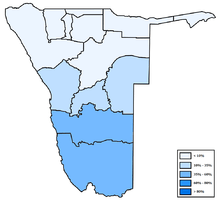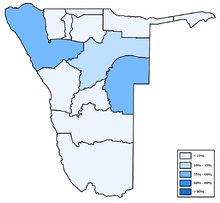Languages of Namibia
Namibia, despite its scant population, is home to a wide diversity of languages, from multiple language families: Indo-European, Bantu, and the various Khoisan families. During apartheid, Afrikaans, German and English held the position of official language; however, after independence from South Africa, Namibia's new government made English the sole official language in the constitution of Namibia. German and Afrikaans were stigmatised as having colonial overtones,[1] while the rising of Mandela's Youth League and the 1951 Defiance Campaign spread English among the masses as the language of the campaign against apartheid.[2]
Language demographics
The most widely spoken languages used in households are Oshiwambo dialects, by 48% of the population, the Khoekhoe language by 11%, Afrikaans by 11%, Kwangali language by 10% and Herero by 10%.[3] Other native languages include the Bantu languages Tswana, Gciriku, Fwe, Kuhane, Mbukushu, Yeyi; and the Khoisan Naro, ǃXóõ, Kung-Ekoka, ǂKxʼauǁʼein and Kxoe.[4] English, the official language, is spoken by less than 1% of people as their native language. Portuguese is spoken by 4–5% of the total population, i.e. 100,000 people, made up mostly of the Angolan community.[5] Among the white population, 60% speak Afrikaans, 32% German, 7% English, and 1% Portuguese.
Indigenous languages are included in the school syllabus at primary level. From secondary level English is the medium of instruction. Afrikaans is the only language that comes close to a lingua franca, and is spoken by most black townspeople together with English and their native language.[6]
-

Distribution of Oshiwambo
-
_in_Namibia.png)
Distribution of Khoekhoe (also known as Nama or Damara)
-

Distribution of Afrikaans
-

Distribution of Otjiherero
-

Distribution of Kavango languages
-

Distribution of Caprivi languages
Percentage distribution of households by main language spoken
| Main language | 2001 | 2011 |
|---|---|---|
| Oshiwambo | 48.5 | 48.9 |
| Nama/Damara | 11.5 | 11.3 |
| Afrikaans | 11.4 | 10.4 |
| Otjiherero | 7.9 | 8.6 |
| Kavango | 9.7 | 8.5 |
| Caprivi | 5.0 | 4.8 |
| English | 1.9 | 3.4 |
| German | 1.1 | 0.9 |
| San | 1.2 | 0.8 |
| Other | 1.8 | 2.4 |
Source: 2001 Census[7] and 2011 Census[8]
See also
References
- ↑ "Namibia Travel Guide". Retrieved 8 July 2010.
- ↑ Brutt-Griffler, J. (2002). World English: a study of its development. Multilingual Matters, p.165. ISBN 1853595772
- ↑ "Languages Spoken in Namibia". About Namibia. Retrieved 8 July 2010.
- ↑ Lewis, M. Paul (ed.) (2009). Ethnologue: Languages of the World, Sixteenth edition. SIL International.
- ↑ "Portuguese to be introduced in schools". The Namibian. Retrieved 19 February 2014.
- ↑ Pütz, Martin (1995). Discrimination through language in Africa?: perspectives on the Namibian experience. Walter de Gruyter, p. 315. ISBN 311014817X
- ↑ 2001 Census
- ↑ 2011 Census